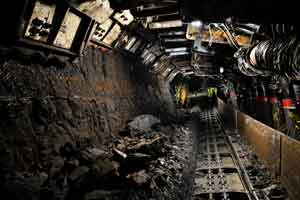What's the Future for Coal?

The use and production of coal is on the decline, pressured by cheap natural gas and policies to promote cleaner sources of energy.
In a recent article in The Regional Economist, Regional Economist Charles Gascon and Senior Research Associate Jonas Crews took a deeper look at the future of coal production as a source for both electricity and jobs in the U.S.
Slumping U.S. Coal Production and Employment
After a modest, consistent rise over a few decades, U.S. coal production started to decline in 2009. By the end of 2016, annual production had fallen 38 percent from its 2008 peak in response to plummeting coal prices, driven largely by rising international supply and declining domestic demand, the authors explained. (For a figure showing these trends, see The Regional Economist article “Coal’s Future Looks Uncertain as Rival Fuels Grow.”)
They noted that countries such as Australia, China and India have steadily increased their mining of coal in the past decade, and the U.S. share of world coal production fell from 18 percent in 2004 to 11 percent by 2014.
Dampened Domestic Demand for Coal
At the same time, demand for U.S. coal has also faded, as a result of reduced electricity demand and increased competition from natural gas and other energy sources.
Supplies of natural gas, coal’s largest competitor, skyrocketed thanks to the use of hydraulic fracturing in the U.S. The authors noted that the average price of natural gas declined from $7 per million British thermal units in 2007 to $3 in the first five months of 2017.1
“In 2016, for the first time in U.S. history, natural gas surpassed coal as the top electricity creator,” Gascon and Crews said, noting that just 16 years ago, natural gas produced only a third of the electricity that coal produced in the U.S.
Government-sponsored research, tax credits and environmental protection laws have also produced more competitors for coal such as wind and solar technologies. “Wind and solar technologies, while not necessarily cost-effective for the U.S. as a whole, are more cost-effective than coal in some areas of the country even without any government support,” the authors noted.
Ebbing Employment in Coal Mining
Coal mining employment has been declining since at least 1985, when data became available. (For a figure showing how coal mining employment has declined, see The Regional Economist article “Coal’s Future Looks Uncertain as Rival Fuels Grow.”)
At the same time, the authors said, labor productivity in U.S. coal production has increased steadily for over three decades, as firms have moved toward complete automation of the mining process. For example, the amount of coal produced by the average mine worker more than tripled from January 1985 to May 2017.
In addition, “natural gas’s price advantage has resulted in coal-fired electricity plants across the country being shut down or retooled for natural gas-fired energy production,” they wrote.
The Long-Term Outlook for Coal and Sources of Optimism
In its 2017 Annual Energy Outlook,2 the U.S Energy Information Administration (EIA) noted that the move away from coal-fired electricity production will likely continue.
The authors pointed out that, according to EIA’s base scenario, electricity production from renewable resources will surpass that of coal by 2030. In addition, labor productivity gains in coal production will further reduce employment in the industry.
However, Gascon and Crews noted there are two areas worthy of optimism:
- The demand for coal used in steel production
- The demand for rare earth elements3 that can be extracted from coal
Coal and Steel Production
Coal needs to have certain characteristics to be used in steel production, and such coal commands a premium over coal used for electricity. “High demand for steel in China and other developing countries has resulted in a large premium over the past several years,” they wrote.
Coal and Rare Earth Elements
Gascon and Crews noted that mining coal for rare earth elements is a more recent phenomenon. These elements are expected to be in high demand for the foreseeable future, due to their use in cell phones, laptops and many other electronics.
They added that the U.S. Department of Energy recently announced it has allocated $7 million toward research on the economic viability of extracting coal from existing mines and removing the carbon from the coal in order to obtain any rare metals within.4
Conclusion
“If new trends in electricity production continue, coal power plants may eventually become obsolete,” the authors concluded. “But if the energy sector has taught us anything, it’s that we can’t rely on trends. New technologies are constantly reshaping our existing industries, and the coal industry could be no different.”
Notes and References
1 A British thermal unit is a measure of energy.
2 Annual Energy Outlook 2017, U.S. Energy Information Administration.
3 Rare earth elements are 17 metallic elements often found together in the Earth’s crust.
4 “DOE Announces $6.9 Million for Research on Rare Earth Elements from Coal and Coal Byproducts,” U.S. Department of Energy, June 9, 2017.
Additional Resources
- Regional Economist: Coal's Future Looks Uncertain as Rival Fuels Grow
- Economic Synopses: The Decline of Coal
- On the Economy: China, Commodities and Emerging Economies
This blog offers commentary, analysis and data from our economists and experts. Views expressed are not necessarily those of the St. Louis Fed or Federal Reserve System.
Email Us
All other blog-related questions

